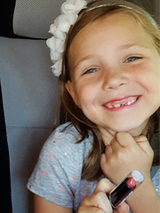Hemiplegic Migraine: Claire’s Story
Hemiplegic Migraine: Claire’s Story
Six-year-old Claire loves to run. According to her mother, Rachel, “Running is her number one thing to do.” Seeing as she spent much of the last year unable to stand up, running must be special delight for Claire.
When Claire was 5, she had a mild fall that left her feeling dizzy. That dizziness quickly progressed to her being unable to use the right side her body. She couldn’t walk or talk. Her parents, Rachel and Don, took her to the emergency room at their local hospital in Lancaster, PA, and from there she was transferred by helicopter to a nearby children’s hospital.

“It was clear that something was seriously wrong with her,” says Rachel. “But the doctors couldn’t figure out what it was.”
After 10 days and countless tests, Claire’s condition had worsened. She had a high fever, started having constant seizures and slipped into a coma.
She was transferred to Children’s Hospital of Philadelphia (CHOP) and admitted to the Intensive Care Unit (ICU). There, she was examined by a team of specialists, including Daniel Licht, MD, a pediatric neurologist, and Matthew Kirschen, MD, a specialist in pediatric neurocritical care.
“When we got to CHOP, I just felt such a sense of relief,” remembers Rachel. “Dr. Kirschen came to me and said, ‘I know you’re worried. I know Claire is very sick. I just want you to know that my first concern is to protect her brain.’”
Finding answers
Not long after the family arrived at CHOP, Dr. Licht told them he believed Claire was suffering from a hemiplegic migraine. Hemiplegic migraine is a rare genetic condition, far more serious than the migraines most people are familiar with. Episodes can produce fever, paralysis, seizures and coma. It would take six to eight weeks to confirm the diagnosis, but the team recommended starting treatment right away.
Claire was given medication to bring her fever down, a medication that acts on the calcium channels on blood vessels, and was monitored closely with an EEG while doctors tried different medications to get her seizures under control. She regained consciousness and started to show signs of improvement, but she was still very weak and couldn’t move her right side. After a week in the ICU, she was moved to the Neurology inpatient unit where she spent another three weeks before being released to inpatient rehabilitation.
Bringing back Claire’s smile
When Claire began rehab, she was still unable to walk, talk or swallow. With the help of physical, occupational and speech therapy, she slowly regained strength and started moving her right side again.
From being able to squish and mold Play Dough with her right hand, to standing up from her wheelchair and taking steps, Claire started making breakthroughs, one after another.
Claire had lost the ability to do things like write letters and numbers and get dressed. Her rehab team worked with her on relearning those things, along with continued strength and coordination exercises.
The final step before she could go home was recovering the ability to swallow. Don was with her the day that came back.
“Up until then she was drooling,” he remembers. “And she just started to swallow that day.” She began eating again by mouth, and her feeding tube was finally removed.
“It was a tough time for all of us, especially Claire,” says Rachel. “At the beginning, she didn’t smile at all. But when she could walk, then run again … her smile came back.”
Claire wasn’t talking yet when she was released from the Hospital, but within a week of being home she started saying words, then began putting them together in short sentences. She continued to make progress with the help of a teacher from the Homebound Instruction program, who came to the house each week.
Four months after her fall and the hemiplegic migraine episode, Claire started kindergarten.
Racing ahead

Today, Claire is in the first grade and loving it. She enjoys spending time with her friends and relishes learning. When she’s not in school or running around, you can find her swimming, camping or hiking.
She has physical, occupational and speech therapy every week. The medicines prescribed by her team at CHOP keep her from having seizures and reduce the risk of another episode. Her parents and the staff at school know the signs to watch for and have rescue medication to administer should she have another hemiplegic migraine.
“She’s a happy little girl who just loves life,” says Rachel. “If you met her you would never know that just a year ago she was fighting this battle. We are forever grateful for the care she received at CHOP.”
Originally published January 2017